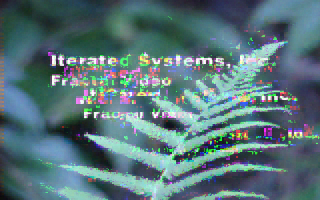I don’t have much energy to work on stuff, so I spent most of my time doing nothing—and occasionally working on fractal formats decoder.
But first of all I’d like to tell that I’ve added another format and a half to na_game_tool. I’m talking about the full-screen animations in Hopkins FBI game. The format by itself is very simple: 640×480 frames, first one is stored uncompressed, the rest use extremely simple compression (values 0x00-0xD2 are pixel values, opcodes 0xD3-0xDD are used to code runs, opcode 0xFC signals end of data, the rest are used to code skips). Why I called it a format and a half? Apparently what I described is true for .anm files that are used to code FMV cutscenes, but there are also .seq files that have the same structure but no opcodes for runs (those are normal pixel values there). Curiously, demo version of the game had ANM.EXE which can also both decode and encode .anm files and has helpful messages too (if you know French).
Anyway, back to the fractal compression. I’m still working out wrinkles in TMM-Frac decoder but it gives a recognizable picture more often than not. Fun thing is that back in the day Alyssa Milburn decompiled the same decoder in FVF (for ScummVM engine) and the video decoding is the same, only container is different. Unfortunately it is a decompile so it reconstructs the original code in the binary specification in C form with minimal improvements (see for yourself). Mind you, it’s a great accomplishment by itself, considering how the code in question is tricky even for modern decompilers (mostly because it uses segment registers to access different kinds of data and similar tricks). But since I care more about understanding how it works than having a working decoder, I’m fine with having a buggy implementation that I can fix eventually.
Here’s a sampler of quickly hacked FVC1 decoder (frame 70 from fernlogo.avi if anybody cares) made by copying my current TMM-Frac decoder core. As you can see, there’s still a lot to fix but there is some progress there too. Mostly it serves as a proof that it’s the same technology in all three cases (I’m yet to write an FVF decoder but it’s undoubtedly the same compression).

Of course when I finish it I’ll try to write a nice format description as it is a bit more complex than “apply affine transformation and contrast adjustment to that block” of pure fractal coding.
Meanwhile Paul has shared a byteVC2 decoder with me and I have to look at that codec eventually (big spoiler: it looks like H.266 rip-off considering how the binary specification mentions ALF, SAO, WPP and such). So many things to procrastinate looking at!
You misspelled B*** codec name.
My “New” idea for intra-frame compression, use 2D auto-correlations for picking which block to use for predictions.
Thanks, amended (it reminds me how there are ISO AAC and IEEE AAC codecs, the latter being Chinese—now it’s the same with Dirac and Chinese H.266 for Social Networks).
As for the idea, I think that’s how motion compensation really started but then they got afraid of the time required for that operation and tried to cheat by limiting range, sampling only certain positions in 2D space, and essentially doing everything else just to make search as short as possible.
And if you really mean searching for all blocks, maybe something like structured elimination will work better (i.e. calculate means of all possible blocks and consider only blocks with the same or minimally different mean as candidates; you need to pre-calculate means just once and you can employ linked lists for searching only the blocks with certain means later).